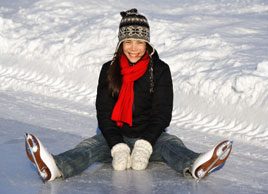9 safety tips for winter sports
Don’t let a mishap spoil your sporty winter fun this year. Instead, take savvy precautions that will ensure your safety on the slopes, ponds, and snowy trails

Source: Web exclusive, November 2009
Skiing and Snowboarding
Use your head
According to the Canadian Ski Patrol, brain injury is the leading cause of disability and death among adults under 45. Jahn Davis, an emergency medical technician, and ski patroller based in Salt Lake, Utah, says the helmet issue is a bit of a no-brainer. ‘Skiing is a fast sport and head injuries can occur at any time. Whether you’re a skier or snowboarder, head protection is a must.’
Accidents don’t just occur at high speeds: actress Natasha Richardson’s tragic accident on a beginner slope in Mt. Tremblant last year prompted prominent ski resort operator Intrawest to implement a mandatory helmet rule.
Learn to fall
Surprisingly, it’s not avoiding falls that will help prevent injury while skiing and snowboarding. ‘Each fall is a teachable moment,’ says Davis. ‘The key lessons are how not to over-correct, attempt to break the fall or try to stay standing on your skis.’ If a skier tries too hard to stay upright, Davis says, the knee bears the brunt of the body’s weight, gravity and speed. ‘In a split second, the ACL (anterior cruciate ligament) breaks, strains or tears.’
Respect boundaries
Following the rules may not always be thrilling, but it can keep you safe. ‘Ducking boundary ropes can lead to skiers and snowboarders getting into extremely dangerous terrain,’ says Davis. ‘Ski patrollers mark boundaries near unsafe slopes and windblown aspects’usually north facing.’
Be cognizant of avalanche potential in the area you’re skiing in, too, by heeding warnings and observing conditions. ‘Avalanche dangers are higher during and right after snowfalls. Any slope greater than 30 degrees can have significant avalanche risks ‘ following posted signs will keep skiers safe.’
If you can’t resist the lure of the out-of-bounds ski or snowboard adventure’even if this story about a couple who were lost in an out-of-bounds ski area doesn’t deter you ‘ or you want to take extra precautions, invest in an avalanche beacon‘a device that sends out radio signals that can help authorities locate you while buried under snow. Finally, educate yourself about avalanche safety.
Snowshoeing
Trail blaze with caution
As with skiing and snowboarding, going off the beaten path when snowshoeing has its dangers. When charting a new course, always bring a map and compass. Also, keep an eye on the sky or your watch and head for home base well before daylight starts to wane. Finally, learn as much as you can about your trail before you go out.
Drink up
Just because the weather isn’t hot doesn’t mean you’re not depleting fluids. In fact, breathing in cold air can be dehydrating, which can cause exhaustion and put you in danger. Bring along a goodsize water bottle and sip steadily.
Dress the part
Snowshoeing is an aerobic activity and even if it’s chilly out, you may break a sweat. Damp clothes can lower body temperature, so dress in layers you can easily take on and off. Wear thermal underwear, a second insulating layer, a fleece vest or jacket, water and windproof pants, and an outer jacket, gloves and hat.
Pack smart
If you’re heading out on a guided trek, all you’ll likely need are your layers, water, sunscreen and a snack. But if you’re planning an off-trail adventure, fill a day pack with the following: two bottles of water, high nutrient snacks such as granola (pack more than you think you’ll need), a small first aid kit, pocket knife, headlamp, compass, extra clothing, emergency blanket, fire starting kit, guidebook and map. It seems like a lot, but you’ll definitely be sorry if you don’t have these items if you need them.
Tell a friend
Don’t head off without telling anyone where you’re going or when you expect to be back‘even if you’re snowshoeing in a group. Leave a note, or better yet, contact a friend or relative and relay your itinerary, then check in once you get home.
Ice Skating
Skate smart
Only ice skate in locations you know are safe, especially when you’re accompanied by children. Look for rinks, ponds and lakes that have posted signs indicating skating is safe. Avoid skating on a lake, river or pond after several days of unseasonably mild weather. Also, familiarize yourself with these Red Cross ice safety tips.
Fall like a pro
Falling the wrong way can cause trouble when skating, too. If you’re a beginner, take the time to learn to skate.
While you’re learning (and even when you’re an experienced skater) protect yourself with wrist guards, knee pads and elbow pads.
Don’t miss out! Sign up for our free weekly newsletters and get nutritious recipes, healthy weight-loss tips, easy ways to stay in shape and all the health news you need, delivered straight to your inbox.




